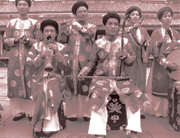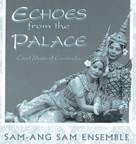

[ Music Index | Metro | Metroactive Central | Archives ]
Eastern Echoes
Two new audiophile recordings capture Cambodian and Vietnamese musical traditions
By Sam Prestianni
MOST Americans' knowledge of Cambodian and Vietnamese culture scarcely extends beyond the bloody imagery of battlefields. Dwelling on past atrocities of the Khmer Rouge or the Tet offensive only serves to color, if not completely obscure, our ability to share in the countries' abundant cultural riches.
The Sam-Ang Sam Ensemble's Echoes From the Palace (Music of the World) and the three-CD set The Music of Vietnam (Celestial Harmonies) endeavor to break through the stereotypes with stunning audiophile recordings of centuries-old musical traditions.
In the liner notes to Echoes, music director Sam-Ang Sam states his mission "to aid in the understanding and appreciation of [rarely documented] traditional Khmer court music, and also to serve as inspiration for Khmer dance troupes around the world."
Blowing a low-pitched quadruple-reed instrument (sralai thomm), the leader coils hypnotic melodies around a tuneful percussion ensemble of up to a dozen members. Remarkably echoing the harmonic waves of Indonesian gamelan, the group layers drums, gongs, xylophones, cymbals and clappers to create a rhythmic buoyancy designed to inspire expression in the dancers. At times the sparkling resonance recalls a steel pan or bubbly crystal orchestra.
A lulling chorus sings themes of beautiful princesses and courtship rituals, ancestral invocations and prayers for the solidarity of the nation. Although the notes include English translations of lyrics and folk tales, knowing the words isn't necessary; the power of the sounds transcends any language gaps.
THE Vietnam compilation works on a similar plane. Of the three volumes, the Imperial Court Music disc rewards with the most immediate, thorough impact.
The other two discs seem like a combined set, focusing on folk melodies, dance pieces, children's songs and modern extensions of traditional forms. The recent tradition-based innovations, which are far removed from the country's diluted pop/rock amalgams (not included here), cull influences from all sounds within earshot.
Vietnamese master improvisers understand that real roots are always in motion. In the extensive notes, producer David Parsons cites their credo: "We'll take things from anywhere--whatever sounds good to us, whatever works." Vietnamese music has always followed this path. A couple of principal lead instruments from the zither family--the 16-string dan tranh and the 36-string dan tam thap luc--claim as relatives the Japanese koto, Iranian santur and Western hammered dulcimer.
The music's emphasis on ornamentation and deep investigation of single-scale nuances is kin to Indian ragas, while the foundation on pentatonic modes sometimes gives the songs an American folk/blues/rock feel. The lilting melodies, which rely on the supple shifts in pitch of bended notes, act like the syllabic inflections of the Chinese tongue.
Some of the tracks allude to highly unusual sources, e.g., an Andean cowpoke canter on the bamboo flute- and lute-based "Anh Van Hanh Quan," and the blues-rock guitar of the amplified, vibrato-laden, single-string dan bau on "Cung Dan Dat Nuoc." Most surprising is the introduction to the ceremonial music of "Ma Vu Bong Man": the thunderous drum roll and blazing jam of the gourd-shaped clarinet sound uncannily like the booming fireworks of a rock show spectacle. Although a comprehensive anthology of Vietnamese traditions is not possible in a mere three discs, 47 tunes over nearly three and a half hours offer an ear-opening overview we all need to experience.
[ Metro | Metroactive Central | Archives ] This page was designed and created by the Boulevards team.

Historical Notes: A Vietnamese ensemble shows off its range of instrumentation.

From the June 6-12, 1996 issue of Metro
Copyright © 1996 Metro Publishing and Virtual Valley, Inc.